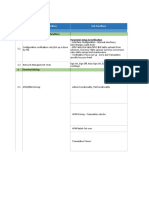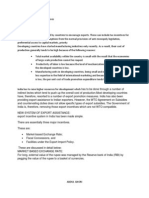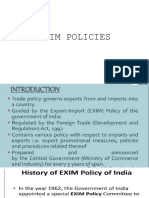Export Promotion+TERM PAPAER
Export Promotion+TERM PAPAER
Uploaded by
Charming AshishCopyright:
Available Formats
Export Promotion+TERM PAPAER
Export Promotion+TERM PAPAER
Uploaded by
Charming AshishCopyright
Available Formats
Share this document
Did you find this document useful?
Is this content inappropriate?
Copyright:
Available Formats
Export Promotion+TERM PAPAER
Export Promotion+TERM PAPAER
Uploaded by
Charming AshishCopyright:
Available Formats
Export Promotion
Introduction
Sustained export growth is crucial for maintaining and accelerating the GDP Growth momentum, increasing employment and alleviating poverty. Since full Liberalization of imports and sharp reduction in transaction costs were expected to take time to implement, several export promotional schemes were introduced in the last two decades. In light of the recent changes introduced in removal of all quantitative restrictions in imports and substantial reduction in import duties and the present proposals to introduce Universal Green Channel and full implementation of EDI (incustoms clearances), it is an opportune time to take stock of all the schemes and to take a view to remove some of them which may have outlived their roles. However, in the transition period, as also suggested by the Prabhu Committee, export incentives need to be maintained so as not to lose the export momentum.
Meaning:It includes measures to encourage export production, export promotion organizations, international marketing assistance and measures to reduce business risks and increase profitability.
CONCEPT: Export development is important to the firm and to the economy as a whole. Export promotion is designed to help firms enter and maintain their position in international markets and to match or counteract similar efforts by other nations.
HOW EXPORT PROMOTIONS ?
Various approaches toward export promotion include: Knowledge transfer Direct or indirect subsidization of export activities Reducing governmental red tape for exporters. Export financing and mixed aid credits to exporters Altered tax legislation for nationals living abroad. Tax benefits to export oriented units. Exports Promotion Zones.
Establishing special institutes for export promotions. Export Promotion for MSME: The capability of Indian MSME products to compete in international markets is reflected in its share of about 40% in national exports. In case of items like Readymade garments Leather goods Processed foods Engineering items, the performance has been commendable both in terms of value and their share.
EXPORT PROMOTION PROGRAMMES
MARKETING ASSISTANCE AND EXPORT PROMOTION SCHEME Plan Scheme Training and Manpower Development' consists of the following Components: Participation in the International Exhibitions/ Fairs. Training Programmes on Packaging for Exports Marketing Development Assistance Scheme for MSME exporters (MSME-MDA) National Award for Quality Products.
Objectives of export promotion measures in India
Compensate the exporters for the high domestic cost of production Provide necessary assistance to the new and small exporters Increase the profitability through export.
ORGANISATIONAL SET-UP
(A).Ministry of Industry and Commerce of India:
Matter related to foreign trade are dealt with by eight divisions in the Department of Commerce 1. Administrative and General Division 2. Finance Division 3. Economic Division
4. Trade Policy Division 5. Foreign Trade Territorial Division 6. Export Products Division 7. Services Division 8. Industries Division
(B)Autonomous Bodies: 1).Export Inspection Council 2).Indian institute of Foreign Trade
Training of personnel in modern techniques of international trade, Organization research in problems of foreign trade, Marketing research, Dissemination of information relating to research and market survey
3).Indian institute of Packaging
It undertake research on raw materials for the packaging industry, Organise training programmes on packaging technology, Stimulate consciousness of the need for good packaging technology etc.
4). Export Promotion Councils, Commodity Boards and Authorities.
Presently, there are fourteen Export Promotion Councils under the administrative control of the Department of Commerce. Some of these Councils are : Chemexcil Pharmexcil Cashew Export Promotion Council Council for Leather Exports Engineering Export Promotion Council, Gems & Jewellery Export Promotion Council Plastics Export Promotion Council Export Promotion Council for EOUs & SEZ Units
For some products, there are Commodity Boards which are responsible for production, development and export ( e.g.Spices Board, Coir Board, Coffee Board, Rubber Board ,Tea Board )
For some other products, MPEDA ( Marine Products Export Development Authority ), APFPEDA ( Agricultural and Processed Food Products Export Development Authority ) are responsible for the development of the industry and export.
5). Federation of Indian Export Organisation.
It provides assistance to Govt. recognized export houses and coordinates export promotion efforts in the field of consultancy services in the country.
6). Indian Council of Arbitration. 7). India Trade Promotion Organisation.
ITPO is formed after the merger of Trade Fair Authority of India and Trade Development Authority of India. The functions of ITPO are Develop and promote export, import and upgrade technology through fairs in India and abroad. Compile and disseminate trade related information. Undertake publicity through the print and electronic media etc.
(C). Public Sector Undertakings:
A public sector undertaking operates under the administrative control of the Ministry of Commerce. State Trading Corporation of India Limited (STC) The Export Credit Guarantee Corporation The Spices Trading Corporation etc.
(D). Advisory Council:
Central Advisory Council on Trade consist of representatives from several organizations advises Govt. on matter relating to EXIM policy programme Operation of Import and Export trade control Organization and development of commercial services etc.
(E). Attached and Subordinate Offices:
1. Office of the Director General of Foreign Trade (DGFT) 2. Directorate General for Commercial Intelligence and Statistics. 3. Offices of Development Commissioners.
INCENTIVES
Export incentives includes
Rebate of duties Rebate of excise duty and custom duties on export to encourage export. Cash compensatory support Cash subsidy designed to compensate the exporter for unrebated indirect taxes and to provide resources for product/market development. Income tax concession Freight subsidy Award
Production Assistance/Facilities
1. Export Processing Zones ( EPZs )
The basic idea behind setting up EPZs is to provide an internationally competitive duty free environment for export promotion at low costs so that exporting units will operate successfully in the international markets. 2. Export Oriented Units (EOUs) Offers a wider source of raw materials, ports of exports, other facilities, availability of technological skills etc. Central Govt. has setup Software Technological Parks since 1991. 3. Agriculture Economic Zone ( AEZs )
It is setup to promote the export of agro and agro- based products. At present there are 45 APZs in India. Central Govt. assist state Govt. in the development of necessary infrastructure, flow of credit and other facilities for promoting agro export.
You might also like
- Message Header: Validation & Authentication of Standing Swift Wire TransferDocument3 pagesMessage Header: Validation & Authentication of Standing Swift Wire TransferCarlo Valencia67% (3)
- Book 4Document33 pagesBook 4Mohammed Abdul KhuddoosNo ratings yet
- Responsive Document - CREW: FDLE: Request For Records in Investigation of Rep. David Rivera: 6/19/2012 - Related Item #13 - Personal Bank AcctsDocument89 pagesResponsive Document - CREW: FDLE: Request For Records in Investigation of Rep. David Rivera: 6/19/2012 - Related Item #13 - Personal Bank AcctsCREWNo ratings yet
- Role of Export Promotion Councils-AnalysisDocument30 pagesRole of Export Promotion Councils-AnalysisSumer BansalNo ratings yet
- Export Promotion: Presented by Rudra Sharma Sanjib BorthakurDocument32 pagesExport Promotion: Presented by Rudra Sharma Sanjib BorthakurkanikabagariaNo ratings yet
- Institutional Infrastructure For Export PromotionDocument68 pagesInstitutional Infrastructure For Export Promotiongagan1509589580% (5)
- Institutional Setup For Export Promotion in IndiaDocument22 pagesInstitutional Setup For Export Promotion in Indiayatin83% (6)
- Export Promotion Frame Work in IndiaDocument31 pagesExport Promotion Frame Work in Indiaankitpandey123No ratings yet
- Export Promotion: BY:-Anuj AggarwalDocument16 pagesExport Promotion: BY:-Anuj AggarwalAnuj AggarwalNo ratings yet
- I E P I: Nstitutional Infrastructure FOR Xport Romotion IN NdiaDocument31 pagesI E P I: Nstitutional Infrastructure FOR Xport Romotion IN NdiaSiva SankariNo ratings yet
- Concep To Export PromotionDocument30 pagesConcep To Export PromotionshailendraNo ratings yet
- Export Assistance and IncentivesDocument10 pagesExport Assistance and IncentivesAbdul Hafeez Ghori100% (2)
- Institutional Set Up For Export Promotion in IndiaDocument7 pagesInstitutional Set Up For Export Promotion in IndiaSammir MalhotraNo ratings yet
- Institutional Set Up For ExportDocument5 pagesInstitutional Set Up For ExportKarmjit KaurNo ratings yet
- International Trade Promotion OrganizationsDocument25 pagesInternational Trade Promotion OrganizationsdelhigalNo ratings yet
- BCO DSE-02-Block-04Document65 pagesBCO DSE-02-Block-04sam andreasNo ratings yet
- Unit 2Document6 pagesUnit 2sandeeppuchakayala143No ratings yet
- Role of Export Promotion Councils in IndiaDocument17 pagesRole of Export Promotion Councils in IndiaSarbeshwar Sahoo100% (1)
- Chapter 3 Export Promotion: International Marketing - Francis CherunilamDocument20 pagesChapter 3 Export Promotion: International Marketing - Francis CherunilamDeepak Rao RaoNo ratings yet
- Intl Marketing Unit 4Document25 pagesIntl Marketing Unit 4Manisha NeelaNo ratings yet
- Export Promoting InstitutesDocument21 pagesExport Promoting InstitutesVikaskundu28100% (1)
- Duty Entitlement Pass Book Scheme (DEPB)Document25 pagesDuty Entitlement Pass Book Scheme (DEPB)Abirami VasudevanNo ratings yet
- Presented By-Alankrita Ayushi GauravDocument18 pagesPresented By-Alankrita Ayushi GauravSanoj KumarNo ratings yet
- Foreign Trade Policy (Exim Policy) : ObjectivesDocument8 pagesForeign Trade Policy (Exim Policy) : ObjectivesanandvmpNo ratings yet
- Trade Policy and Regulations of IndiaDocument8 pagesTrade Policy and Regulations of IndiaDeepika SinghNo ratings yet
- EXPORT IMPORT PROCEDURES AND DOCUMENTATION UNIT 4Document20 pagesEXPORT IMPORT PROCEDURES AND DOCUMENTATION UNIT 4aayushirai30No ratings yet
- Role of Government and Other Agencies in Growth of International MarketingDocument20 pagesRole of Government and Other Agencies in Growth of International MarketingViral BarotNo ratings yet
- Export Promotion Measures in IndiaDocument3 pagesExport Promotion Measures in IndiaujwalaNo ratings yet
- International Marketing Chapter-20 Export PromotionDocument18 pagesInternational Marketing Chapter-20 Export PromotionAdil Bin KhalidNo ratings yet
- BE Assignment FinalDocument24 pagesBE Assignment FinalRamneet ParmarNo ratings yet
- Unit 14Document10 pagesUnit 14Preet kesharwaniNo ratings yet
- DGFT and EpcDocument12 pagesDGFT and EpcamitNo ratings yet
- Advisory Bodies Board of TradeDocument4 pagesAdvisory Bodies Board of Trademiss nairNo ratings yet
- Foreign Trade PolicyDocument18 pagesForeign Trade PolicyDhaval BhattNo ratings yet
- Export Promotion OrganisationDocument5 pagesExport Promotion Organisationvarun410No ratings yet
- Export Promotion Measures SpectrumDocument15 pagesExport Promotion Measures SpectrumGodwin PereiraNo ratings yet
- ExportDocument10 pagesExportoverkillNo ratings yet
- Export Promotion CouncilsDocument14 pagesExport Promotion Councilspallavij0044No ratings yet
- Government Agencies Funding International TradeDocument7 pagesGovernment Agencies Funding International TradenofaNo ratings yet
- Exim PolicyDocument22 pagesExim PolicyTarun Arora100% (1)
- Export and Import Management MaterialDocument55 pagesExport and Import Management MaterialVenugopalNo ratings yet
- Export Import PolicyDocument66 pagesExport Import PolicycinemaasuraNo ratings yet
- Ftpnew 120229063553 Phpapp02Document90 pagesFtpnew 120229063553 Phpapp02Marketing HydNo ratings yet
- Government Initiatives To Promote Exports and Social Compliance StandardsDocument24 pagesGovernment Initiatives To Promote Exports and Social Compliance StandardsShrutiNo ratings yet
- Export Promotion InfrastructureDocument6 pagesExport Promotion Infrastructurecool4330No ratings yet
- Foreign Trade Notes -1Document8 pagesForeign Trade Notes -1Yuvraj SoniNo ratings yet
- Export Promotion Measures in India: 1. International PresenceDocument8 pagesExport Promotion Measures in India: 1. International PresencePrajjwal AgrawalNo ratings yet
- What Is Chemexcil Common 2013Document33 pagesWhat Is Chemexcil Common 2013Gaurav NavaleNo ratings yet
- Export MarketingDocument15 pagesExport MarketingSakurra Stroescu100% (1)
- Export ManagementDocument33 pagesExport ManagementTanmoy ChakrabortyNo ratings yet
- UNIT 3 Institutional Infrastructure For Exports SHORT NOTESDocument6 pagesUNIT 3 Institutional Infrastructure For Exports SHORT NOTESSHREYA THAKURNo ratings yet
- Chap 7Document7 pagesChap 7Siva SankariNo ratings yet
- Import Substitution and Export Promotion As Development StrategiesDocument11 pagesImport Substitution and Export Promotion As Development StrategiesSuraj KumarNo ratings yet
- Role & Functions of Exim BankDocument21 pagesRole & Functions of Exim BankPrathap AnNo ratings yet
- Unit 6 FTPDocument41 pagesUnit 6 FTPShahrukh SaifiNo ratings yet
- Unit III Role and Functions of EXIM BankDocument17 pagesUnit III Role and Functions of EXIM BankbpsunilmbaNo ratings yet
- Export ManagementDocument97 pagesExport ManagementParikshit Kumar 27No ratings yet
- Formulative and Advisory Bodies 2Document38 pagesFormulative and Advisory Bodies 2Megha SharmaNo ratings yet
- Overview of Foreign Trade Policy Gptaie Ms Alka: Amity International Business School Amity International Business SchoolDocument49 pagesOverview of Foreign Trade Policy Gptaie Ms Alka: Amity International Business School Amity International Business SchoolDeepanshu BhattNo ratings yet
- Assignment EPC and CBDocument4 pagesAssignment EPC and CBAbhishek TalakatnalNo ratings yet
- The Road To Successful Trade Shows: "Let the Customer Find You!"From EverandThe Road To Successful Trade Shows: "Let the Customer Find You!"No ratings yet
- Smooth Sailing: A Quick Guide to Effective Cargo Import and Export: Logistics, #1From EverandSmooth Sailing: A Quick Guide to Effective Cargo Import and Export: Logistics, #1No ratings yet
- Tarun Sharma Final Mini ProjectDocument4 pagesTarun Sharma Final Mini ProjectMeme PurNo ratings yet
- Priceline Investment ThesisDocument7 pagesPriceline Investment ThesisSomeToWriteMyPaperFayetteville100% (2)
- KPPKD ADocument531 pagesKPPKD ARishabhrajRajendra100% (1)
- 1050-Article Text-1920-1-10-20180102Document5 pages1050-Article Text-1920-1-10-20180102LathaNo ratings yet
- The Ultimate Guide To IBM Certified Application Developer - Operational Decision Manager Standard V8.9.1Document2 pagesThe Ultimate Guide To IBM Certified Application Developer - Operational Decision Manager Standard V8.9.1StefanNo ratings yet
- Case Study On Malaysian CompaniesDocument2 pagesCase Study On Malaysian CompaniesAldinNo ratings yet
- IB Cs 3Document3 pagesIB Cs 3Abhijna V CNo ratings yet
- Receipt: Transfer OverviewDocument3 pagesReceipt: Transfer OverviewIndo TrackingNo ratings yet
- Project Section 2 BSBLDR602 Meeting Minutes Template To CompleteDocument4 pagesProject Section 2 BSBLDR602 Meeting Minutes Template To CompleteTatsu OkadaNo ratings yet
- Operations MGT Module #14Document5 pagesOperations MGT Module #14Jude VicenteNo ratings yet
- 590+ Principles of Management Chapter-Wise Solved MCQs With PDF DownloadDocument38 pages590+ Principles of Management Chapter-Wise Solved MCQs With PDF DownloadRichard GaurabNo ratings yet
- Service Marketing - Marriott InternationalDocument9 pagesService Marketing - Marriott Internationalmanish menonNo ratings yet
- Fauji Foods Afsr FinalDocument18 pagesFauji Foods Afsr FinalHalimah SheikhNo ratings yet
- Excel - Vali InvoiceDocument1 pageExcel - Vali Invoicemaazhu78No ratings yet
- ToR CRM RE-MODELINGDocument13 pagesToR CRM RE-MODELINGMOOTUMMA DUGASA UMANo ratings yet
- New Foreign Trade Policy 2021-26 Summary India UPDocument5 pagesNew Foreign Trade Policy 2021-26 Summary India UPMadhav ZoadNo ratings yet
- SJP Trust Form MandateDocument14 pagesSJP Trust Form MandateedwardjonesllpukNo ratings yet
- 5S PDFDocument12 pages5S PDFMaui FloresNo ratings yet
- Lecture 2Document30 pagesLecture 2Tesfaye ejetaNo ratings yet
- Brand Names and Branding IssuesDocument31 pagesBrand Names and Branding Issuesshivakumar NNo ratings yet
- Employee Engagement PDFDocument17 pagesEmployee Engagement PDFHarleen KaurNo ratings yet
- Search+Engine+Marketing+ (SEM) +certification+ +upgrad+ +16.02.2020Document49 pagesSearch+Engine+Marketing+ (SEM) +certification+ +upgrad+ +16.02.2020MallowNo ratings yet
- Cbme 1 TQMDocument62 pagesCbme 1 TQMEdrymae Tobias100% (1)
- Presentation of CVP FinalDocument34 pagesPresentation of CVP FinalMonir HossanNo ratings yet
- Product and Brand Management Notes-9-12Document4 pagesProduct and Brand Management Notes-9-12Makarand WathNo ratings yet
- Letter of AppointmentDocument3 pagesLetter of AppointmentMark LagahitNo ratings yet
























































































